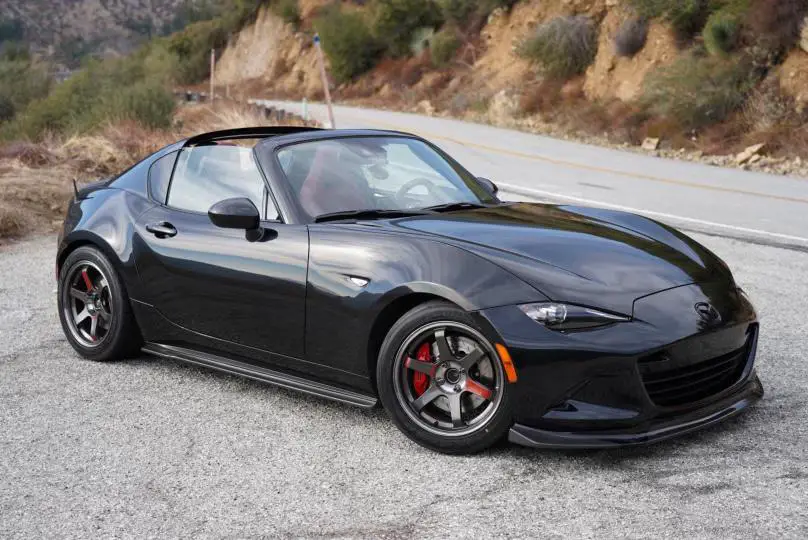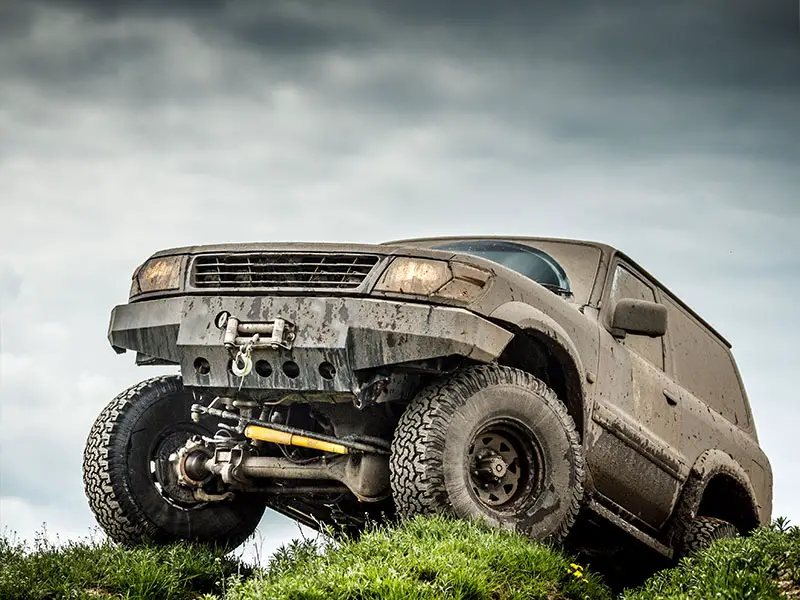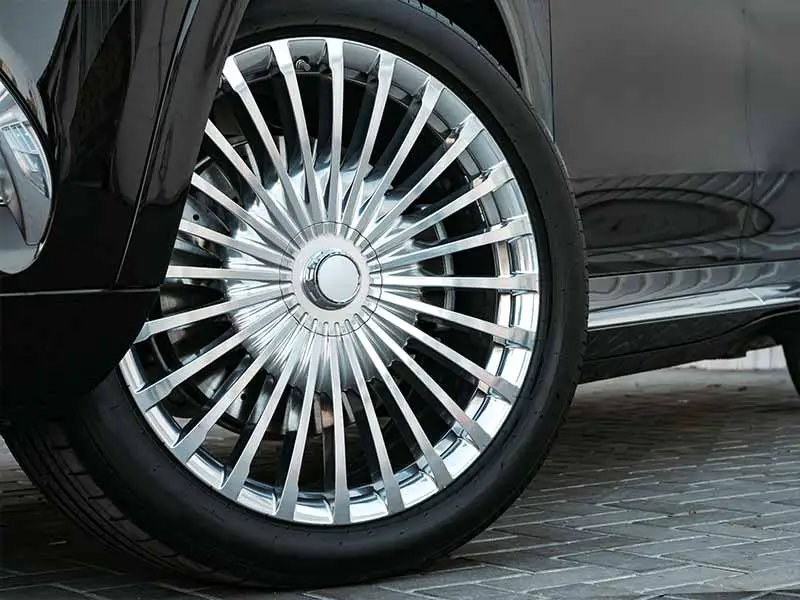Picture this: you’re cruising down the highway, and you can’t help but notice the different types of wheels on the cars around you. Some have larger diameter wheels and shorter sidewall tires, while others have smaller wheels with taller sidewalls. But what difference does it make?
Bigger Wheels Vs Smaller Wheels
Bigger wheels with lower profile tires can improve handling and offer a sportier look, but may result in a less comfortable ride and higher costs.
Small wheels with taller profile tires provide a more comfortable ride and better off-road capability but might have reduced handling and a less sporty appearance.
In this article, we’ll explore the differences between smaller and larger wheel diameter, examining their advantages and downsides in terms of handling, appearance, comfort, fuel efficiency, rolling resistance, and unsprung weight to help you make an informed decision for your car or truck.
Let’s take a closer look.

Bigger Wheels and Low Profile Tires
So, what are low profile tires? These are tires with a shorter sidewall (the part of the tire between the wheel and the tread) and a wider tread. When you hear people talk about larger wheels, they usually mean wheels with low profile tires.
Now, let’s dive into the advantages of larger wheels:
- Improved handling and steering response: Low profile tires make your car feel more responsive to your actions. Because they have shorter sidewalls, these tires can handle turns and bends with less sidewall flex, making your ride feel sportier and more responsive.
- Enhanced aesthetics and sporty look: Larger wheels can give your car a sleek and stylish appearance. Many people think they look cool, and they’re often seen on sports cars or high-performance vehicles.
- Better grip and traction on dry surfaces: Since lower profile tires have a wider tread, they provide more contact with the road. This extra grip can improve your car’s handling and stability, especially when driving on dry surfaces or taking sharp turns.
- Fuel efficiency and rolling resistance: Bigger rims typically have more rolling resistance due to having more weight. This means that they require more energy to move, which can lead to lower fuel efficiency.
Of course, there are some downsides to large wheels:
- Decreased ride quality: With less cushion from the shorter sidewalls, you might feel more bumps and vibrations while driving. This can make for a less comfortable ride, especially on rough or uneven surfaces.
- Increased risk of tire and wheel damage: Lower profile tires are more vulnerable to damage from potholes and road debris. Plus, since the wheel is closer to the ground, it’s at a higher risk of getting scratched or dented.
- Higher cost: Larger wheels and lower profile tires can be more expensive to buy and maintain. The tires themselves often have a higher price tag, and they might wear out faster, meaning you’ll have to replace them more often.
- Increased unsprung weight: Larger wheel size usually means more weight. This extra weight, known as unsprung weight, can negatively impact your vehicle’s suspension system and handling, especially when driving over uneven surfaces or encountering bumpy roads and potholes.

Smaller Wheels and Taller Sidewalls
What exactly are taller sidewalls and greater aspect ratio? Well, taller sidewalls refer to the part of the tire between the wheel and the tread being taller, which means a greater aspect ratio. So when we talk about small wheels, we’re typically discussing wheels with taller sidewalls and a greater aspect ratio, keeping the width similar to the larger wheels.
Let’s look at the benefits of choosing wheels with a smaller diameter:
- Increased ride comfort: Thanks to the extra cushion provided by taller sidewalls, you’ll feel fewer bumps and vibrations on the road. This can make your ride smoother and more comfortable, especially when driving on rough or uneven surfaces.
- Better off-road capability: If you like going on off-road adventures, small wheel size can be a good choice. The extra cushion from the taller sidewalls helps protect the wheel and tire from damage caused by rocks, potholes, or other obstacles you might encounter off-road.
- Improved fuel efficiency and reduced rolling resistance: A small wheel will generally have less rolling resistance than larger wheels. This is because their lower unsprung weight requires less energy to move. As a result, vehicles equipped with small wheels tend to get better fuel economy.
Just like with larger wheels, there are some downsides to choosing smaller diameter wheels:
- Reduced handling and steering response: Since taller sidewalls can flex more, your car might feel less responsive and nimble when you’re turning or cornering. This could make your ride feel less sporty and slightly less engaging.
- Less sporty appearance: Small wheels might not look as stylish or sporty as larger diameter wheels with their compact tire sidewalls. Depending on your preferences, this may or may not be a concern for you.
Understanding Tire Size Numbers
It’s important to know how to read and understand tire size numbers. These numbers are usually found on the sidewall of the tire and provide essential information about its dimensions and specifications.
Tire size numbers are composed of three main elements: width, aspect ratio, and diameter. Let’s break down each element:
- Section Width: The first number in the tire size represents its width in millimeters. For example, if the tire size is 225/50R17, the width is 225 millimeters. This number indicates the width of the tire from one sidewall to the other, or the section width.
- Aspect Ratio: The second number, following a forward slash (/), represents the tire’s aspect ratio. This number is a percentage that shows the relationship between the tire’s sidewall height and its width. In our example of 225/50R17, the aspect ratio is 50. This means the sidewall height is 50% of the tire’s width (225 millimeters). A lower aspect ratio indicates a lower profile tire with shorter sidewalls, while a higher aspect ratio represents a tire with taller sidewalls.
- Wheel Diameter: The last number in the tire size sequence, preceded by the letter “R” (which stands for radial construction), refers to the diameter of the wheel in inches. In the example of 225/50R17, the diameter is 17 inches. This number tells you the size of the wheel that the tire is designed to fit.
Tire Size Comparison Calculator
Maintaining the Rolling Diameter of the OEM Wheel Assembly
Rolling diameter is the distance that your tire travels in one complete rotation. When you change your wheel size, it’s important to maintain the tire circumference as close as possible to the original equipment (OEM) wheel assembly.
So, why is it important to maintain the same overall size?
- Preserving vehicle handling and stability: When your new wheels and tires have a similar diameter to the original factory-supplied tire, your car’s handling and stability stay closer to the original design. This means your vehicle continues to perform well and stays safe on the road.
- Maintaining accurate odometer and speedometer readings: Your vehicle’s speedometer and odometer rely on knowing the tire diameter to give you accurate readings. If the new wheels and tires have a significantly different diameter, your speedometer and odometer readings could be off, which can lead to speeding tickets or incorrect mileage records.
What happens if you don’t keep the size within a reasonable margin of error?
- Compromised safety and vehicle performance: A big difference in tire circumference can affect your car’s braking, acceleration, and handling. This can make your vehicle less safe to drive and potentially lead to accidents.
- Inaccurate speedometer and odometer readings: As mentioned earlier, not maintaining the original diameter can throw off your speedometer and odometer readings. This can be dangerous and cause issues when you need to track your vehicle’s mileage.
- Increased wear and tear on suspension components: A significant change in wheel and tire circumference can put extra stress on your car’s suspension system. Over time, this can lead to increased wear and tear, resulting in more frequent repairs and higher maintenance costs.
Resources
Below are some links you may find helpful when learning about tires
- What difference does wheel size make? – Cars.com
- A guide to vehicle wheel sizes: Do they matter? – Car And Driver
Final Thoughts
Let’s recap what we’ve learned about larger wheels with tires that have less sidewall height and small wheels with the tire’s sidewall height increased:
- Larger wheels and shorter sidewall height tires can offer better handling, a sportier look, but may result in a less comfortable ride, higher fuel consumption, increased risk of damage, and higher costs.
- Smaller wheels with taller sidewalls provide a more comfortable ride and better off-road capability, but they might also have reduced handling and a less sporty appearance.
When choosing wheel size for your vehicle, remember to think about your specific needs and preferences. Whether you want a smooth, comfortable ride or a sportier, more responsive feel, your ideal wheel size will depend on your priorities and the type of driving you do.
Good luck and happy motoring.





